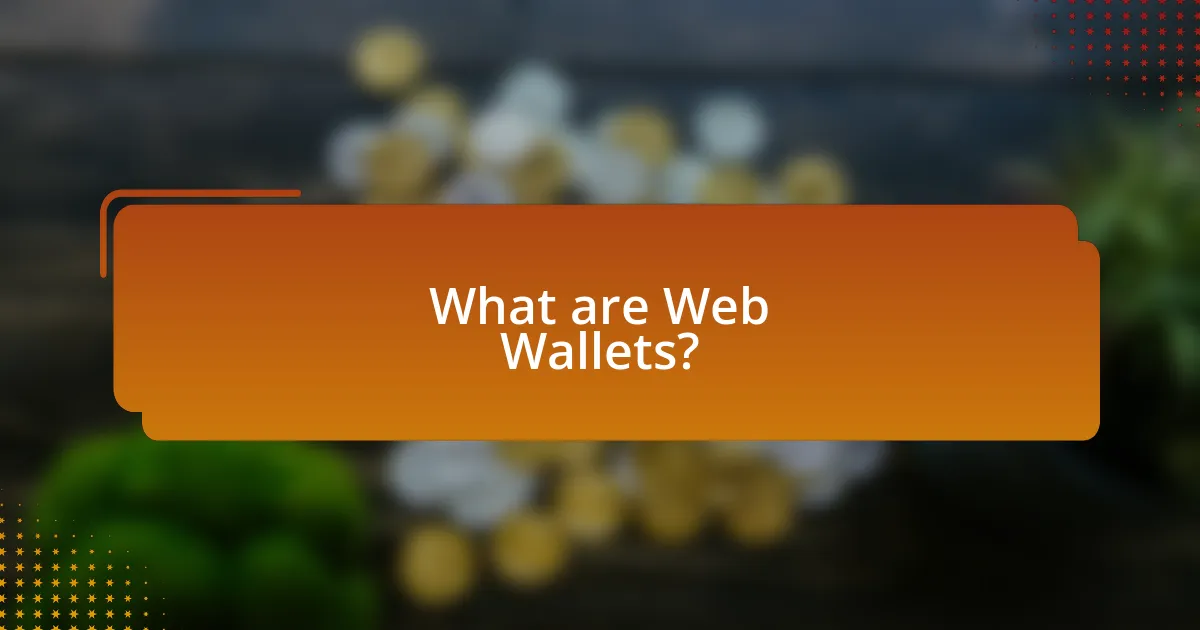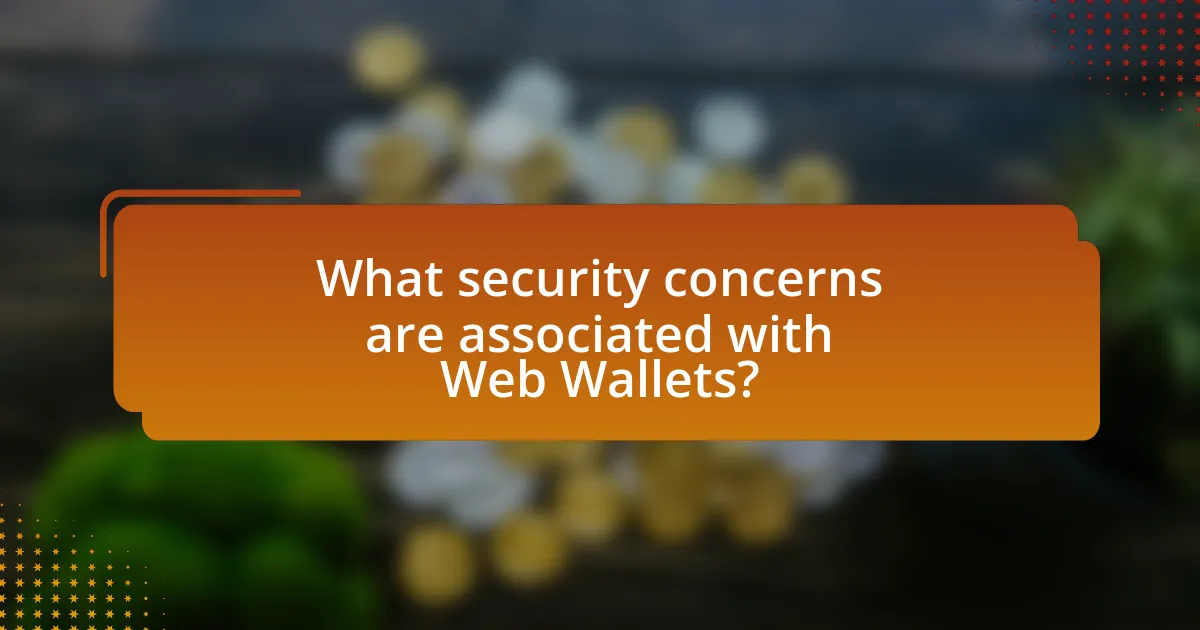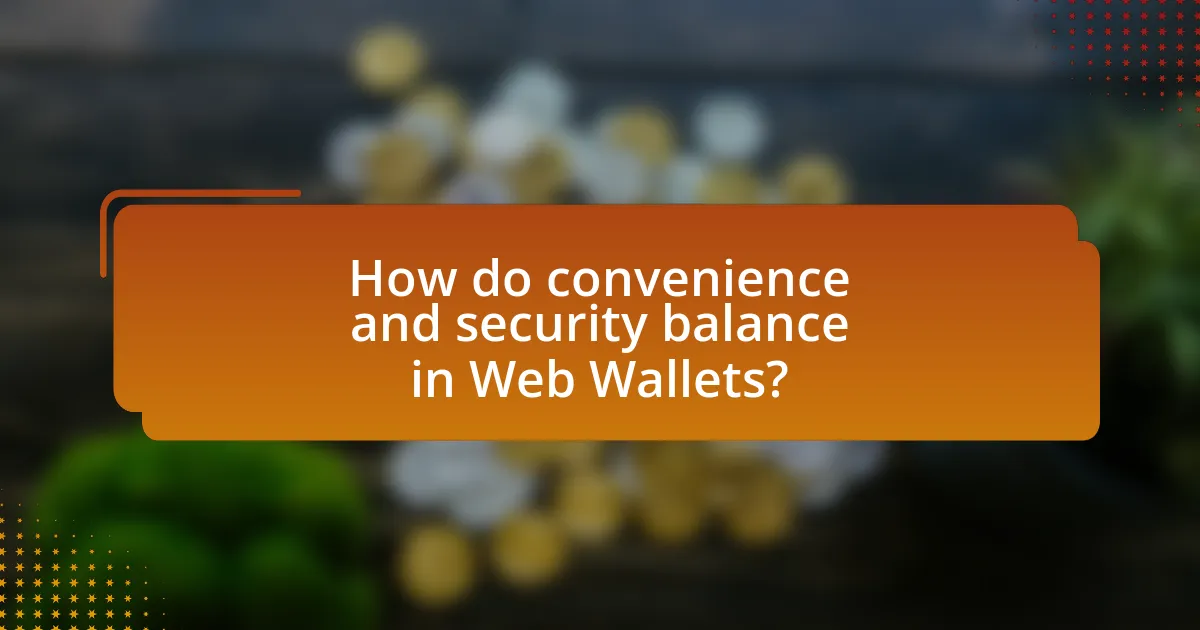Web wallets are online platforms that enable users to store, send, and receive cryptocurrencies through a web browser, offering convenience and accessibility without the need for software downloads or direct management of private keys. This article provides an overview of web wallets, detailing their functionality within the digital ecosystem, the technologies that support them, and the various types available, including hosted, client-side, and hybrid wallets. It also examines the balance between convenience and security, highlighting the vulnerabilities associated with web wallets, such as susceptibility to hacking and phishing attacks, while discussing best practices for enhancing security. Additionally, the article explores future trends that may impact web wallets, including advancements in biometric security and the integration of decentralized finance platforms.

What are Web Wallets?
Web wallets are online platforms that allow users to store, send, and receive cryptocurrencies through a web browser. These wallets facilitate easy access to digital assets without the need for downloading software or managing private keys directly, making them convenient for everyday transactions. According to a report by Statista, as of 2021, over 40% of cryptocurrency users preferred web wallets due to their user-friendly interfaces and accessibility from any device with internet connectivity.
How do Web Wallets function in the digital ecosystem?
Web wallets function as online platforms that allow users to store, send, and receive digital currencies or assets through a web interface. They operate by securely managing private keys and facilitating transactions via the internet, enabling users to access their funds from any device with internet connectivity. Web wallets typically utilize encryption and security protocols to protect user data and transactions, making them convenient for everyday use while also presenting potential security risks, such as susceptibility to hacking. According to a report by the Blockchain Research Institute, the ease of access provided by web wallets has contributed to their popularity, with millions of users relying on them for cryptocurrency transactions.
What technologies underpin Web Wallets?
Web wallets are primarily underpinned by technologies such as blockchain, encryption, and web-based APIs. Blockchain technology enables secure and transparent transactions by maintaining a decentralized ledger of all transactions. Encryption ensures that sensitive user data, including private keys and personal information, is protected from unauthorized access. Web-based APIs facilitate the integration of various services, allowing users to interact with their wallets seamlessly across different platforms. These technologies collectively enhance the functionality and security of web wallets, making them a popular choice for digital asset management.
How do users interact with Web Wallets?
Users interact with Web Wallets primarily through web browsers, enabling them to send, receive, and store cryptocurrencies. This interaction typically involves creating an account, logging in, and utilizing features such as transaction history, balance checks, and integration with exchanges. According to a report by Statista, as of 2023, over 40% of cryptocurrency users prefer Web Wallets for their ease of access and user-friendly interfaces, highlighting their role in facilitating everyday transactions.
What types of Web Wallets are available?
There are several types of web wallets available, including hosted wallets, client-side wallets, and hybrid wallets. Hosted wallets are managed by third-party service providers, allowing users to access their funds through a web interface without needing to manage private keys. Client-side wallets, on the other hand, store private keys on the user’s device while still providing web access, enhancing security. Hybrid wallets combine features of both hosted and client-side wallets, offering a balance between convenience and security. Each type serves different user needs, with hosted wallets prioritizing ease of use and client-side wallets focusing on enhanced security.
What distinguishes hot wallets from cold wallets?
Hot wallets are distinguished from cold wallets primarily by their connectivity to the internet. Hot wallets, such as online exchanges and mobile apps, allow for quick access and transactions, making them convenient for frequent trading. In contrast, cold wallets, which include hardware wallets and paper wallets, are offline and provide enhanced security against hacking and online threats. The increased security of cold wallets is evidenced by their isolation from the internet, which significantly reduces the risk of unauthorized access.
How do custodial wallets differ from non-custodial wallets?
Custodial wallets differ from non-custodial wallets primarily in the control of private keys. In custodial wallets, a third party manages the private keys on behalf of the user, meaning the user must trust this entity to secure their funds. Conversely, non-custodial wallets allow users to retain full control over their private keys, enhancing security but requiring users to take personal responsibility for safeguarding their assets. This distinction is crucial as it impacts the level of security and trust involved in managing cryptocurrency.
What are the primary advantages of using Web Wallets?
The primary advantages of using Web Wallets include convenience, accessibility, and ease of use. Web Wallets allow users to access their funds from any device with internet connectivity, facilitating quick transactions without the need for physical hardware. Additionally, they often provide user-friendly interfaces that simplify the process of sending and receiving cryptocurrencies. According to a report by Statista, as of 2023, over 40% of cryptocurrency users prefer Web Wallets for their straightforward setup and management, highlighting their popularity and effectiveness in meeting user needs.
How do Web Wallets enhance user convenience?
Web wallets enhance user convenience by providing easy access to digital assets through a user-friendly interface and seamless integration with various platforms. Users can quickly send and receive cryptocurrencies without the need for complex software installations or hardware devices. Additionally, web wallets often support multiple currencies, allowing users to manage different assets in one place, which simplifies transactions and reduces the time spent on managing multiple wallets. According to a report by Statista, the global number of cryptocurrency users reached over 300 million in 2021, indicating a growing demand for accessible solutions like web wallets that cater to both novice and experienced users.
What role do Web Wallets play in facilitating transactions?
Web wallets facilitate transactions by providing a digital platform for users to store, send, and receive cryptocurrencies or digital currencies securely and conveniently. They enable quick access to funds and streamline the transaction process, allowing users to make payments with minimal friction. For instance, web wallets often integrate with various online services, enabling users to complete purchases or transfers without needing to manually input wallet addresses or transaction details each time. This efficiency is supported by the fact that web wallets can utilize features like QR codes and one-click payments, enhancing user experience and transaction speed.

What security concerns are associated with Web Wallets?
Web wallets face significant security concerns, primarily due to their reliance on internet connectivity and centralized storage. These wallets are vulnerable to hacking, phishing attacks, and malware, which can lead to unauthorized access and theft of funds. For instance, a 2021 report by Chainalysis indicated that over $7.7 billion was stolen from cryptocurrency exchanges and wallets, highlighting the risks associated with web-based storage solutions. Additionally, users may inadvertently expose their private keys or login credentials through insecure networks or phishing schemes, further increasing the likelihood of financial loss.
How vulnerable are Web Wallets to cyber threats?
Web wallets are highly vulnerable to cyber threats due to their reliance on internet connectivity and centralized storage of private keys. This vulnerability is evidenced by the increasing number of hacking incidents; for instance, in 2021, over $3 billion was stolen from various cryptocurrency exchanges and wallets, with web wallets being a primary target. Additionally, web wallets often lack robust security measures such as two-factor authentication, making them susceptible to phishing attacks and malware. The combination of these factors significantly increases the risk of unauthorized access and theft of digital assets stored in web wallets.
What types of attacks target Web Wallets?
Web wallets are primarily targeted by phishing attacks, malware, and man-in-the-middle attacks. Phishing attacks involve deceiving users into providing their login credentials through fake websites or emails, which can lead to unauthorized access to their wallets. Malware can be used to capture sensitive information or manipulate transactions without the user’s knowledge. Man-in-the-middle attacks occur when an attacker intercepts communication between the user and the wallet service, allowing them to steal information or alter transactions. These attack types are prevalent due to the increasing reliance on web wallets for cryptocurrency transactions, making them attractive targets for cybercriminals.
How can users protect their Web Wallets from breaches?
Users can protect their Web Wallets from breaches by implementing strong security measures such as enabling two-factor authentication (2FA), using complex and unique passwords, and regularly updating their software. Two-factor authentication adds an extra layer of security by requiring a second form of verification, making unauthorized access significantly more difficult. According to a study by Google, 2FA can block 100% of automated bots and 96% of phishing attacks. Additionally, using complex passwords that combine letters, numbers, and symbols reduces the risk of password cracking. Regular software updates ensure that users benefit from the latest security patches, which protect against known vulnerabilities.
What measures can enhance the security of Web Wallets?
To enhance the security of web wallets, implementing multi-factor authentication (MFA) is essential. MFA adds an extra layer of protection by requiring users to provide two or more verification factors to gain access, significantly reducing the risk of unauthorized access. According to a study by the Cybersecurity & Infrastructure Security Agency, MFA can block over 99% of automated cyberattacks, demonstrating its effectiveness in safeguarding sensitive information. Additionally, using strong, unique passwords and regularly updating them further fortifies security, as weak passwords are a common vulnerability exploited by attackers. Regular software updates and security patches also play a crucial role in protecting web wallets from known vulnerabilities, as highlighted by the National Institute of Standards and Technology, which emphasizes the importance of maintaining up-to-date security measures.
How effective are two-factor authentication and encryption?
Two-factor authentication (2FA) and encryption are highly effective security measures for protecting web wallets. 2FA adds an additional layer of security by requiring users to provide two forms of identification before accessing their accounts, significantly reducing the risk of unauthorized access. According to a study by Google, implementing 2FA can block 99.9% of automated attacks on accounts. Encryption, on the other hand, secures data by converting it into a format that can only be read by authorized users, making it difficult for attackers to access sensitive information. The use of strong encryption protocols, such as AES-256, is widely recognized as a standard for securing data in transit and at rest, further enhancing the security of web wallets. Together, these measures create a robust defense against cyber threats, ensuring the safety of users’ digital assets.
What best practices should users follow for secure usage?
Users should follow several best practices for secure usage of web wallets, including enabling two-factor authentication (2FA), using strong and unique passwords, and regularly updating software. Enabling 2FA adds an extra layer of security, making unauthorized access significantly more difficult. Strong, unique passwords reduce the risk of account compromise, as studies show that 81% of data breaches are linked to weak passwords. Regularly updating software ensures that users benefit from the latest security patches, which can protect against known vulnerabilities. Additionally, users should avoid accessing wallets over public Wi-Fi networks, as these can expose sensitive information to potential attackers.

How do convenience and security balance in Web Wallets?
Convenience and security in web wallets are balanced through the implementation of user-friendly interfaces alongside robust security measures. Web wallets prioritize ease of access, allowing users to quickly send and receive funds, while simultaneously employing encryption, two-factor authentication, and regular security audits to protect user data. For instance, a study by the European Union Agency for Cybersecurity highlights that 70% of web wallet providers utilize multi-factor authentication to enhance security without compromising user experience. This dual focus ensures that users can efficiently manage their digital assets while maintaining a secure environment.
What trade-offs exist between convenience and security in Web Wallets?
Web wallets offer a trade-off between convenience and security, where ease of access often compromises the level of protection for users’ assets. For instance, web wallets typically allow quick transactions and easy management of funds through user-friendly interfaces, which can lead to vulnerabilities such as phishing attacks or unauthorized access. According to a report by the Cybersecurity & Infrastructure Security Agency, 90% of data breaches are due to human error, highlighting the risks associated with convenience-focused designs. In contrast, more secure wallets, such as hardware wallets, require additional steps for access and transaction approval, which can deter users seeking immediate access. Thus, while web wallets prioritize user experience, they inherently expose users to greater security risks.
How do user preferences influence the choice of Web Wallets?
User preferences significantly influence the choice of Web Wallets by determining the balance between convenience and security that users seek. For instance, users who prioritize ease of use may opt for wallets with simple interfaces and quick transaction processes, while those concerned about security might choose wallets that offer advanced encryption and two-factor authentication. A survey conducted by Statista in 2022 revealed that 45% of users selected Web Wallets based on security features, while 35% prioritized user-friendly design. This data illustrates that user preferences directly shape the features and functionalities that Web Wallets must offer to attract and retain customers.
What compromises might users face when prioritizing one over the other?
Users prioritizing convenience over security in web wallets may face increased vulnerability to hacking and fraud, as easier access often means weaker security measures. For instance, a study by the Cybersecurity & Infrastructure Security Agency indicates that 60% of breaches occur due to inadequate security protocols. Conversely, if users prioritize security, they may experience slower transaction times and a more complex user interface, which can hinder usability and accessibility. This trade-off highlights the inherent tension between user-friendly features and robust security measures in web wallets.
What future trends could impact Web Wallets?
Future trends that could impact web wallets include the rise of decentralized finance (DeFi), increased regulatory scrutiny, and advancements in biometric security. Decentralized finance is gaining traction, with a report from DeFi Pulse indicating that the total value locked in DeFi protocols surpassed $80 billion in 2021, which could lead to more users adopting web wallets for seamless access to these services. Regulatory scrutiny is also increasing, as governments worldwide are implementing stricter regulations on cryptocurrency transactions, which could affect how web wallets operate and ensure compliance. Additionally, advancements in biometric security, such as facial recognition and fingerprint scanning, are becoming more prevalent, enhancing the security of web wallets and potentially increasing user trust and adoption.
How might advancements in technology affect Web Wallet security?
Advancements in technology can significantly enhance Web Wallet security by introducing more robust encryption methods and multi-factor authentication systems. For instance, the implementation of quantum encryption could provide a level of security that is currently unattainable with classical encryption methods, making it nearly impossible for unauthorized users to access sensitive information. Additionally, the integration of artificial intelligence in fraud detection can analyze transaction patterns in real-time, identifying and mitigating potential threats before they can cause harm. According to a report by the International Journal of Information Security, the use of AI in cybersecurity has been shown to reduce the risk of breaches by up to 50%. These technological improvements not only bolster security measures but also instill greater user confidence in Web Wallets, ultimately leading to wider adoption and usage.
What emerging features could enhance user convenience in Web Wallets?
Emerging features that could enhance user convenience in Web Wallets include biometric authentication, integration with decentralized finance (DeFi) platforms, and automated transaction categorization. Biometric authentication, such as fingerprint or facial recognition, streamlines the login process and enhances security, as evidenced by a study showing that 70% of users prefer biometrics over traditional passwords for ease of access. Integration with DeFi platforms allows users to manage their assets seamlessly, facilitating instant transactions and lending opportunities, which can significantly improve user experience. Automated transaction categorization leverages machine learning to organize spending habits, providing users with insights and simplifying financial management, a feature that has been shown to increase user engagement by 30% in financial applications.
What practical tips can users follow for safe Web Wallet usage?
To ensure safe Web Wallet usage, users should enable two-factor authentication (2FA) to add an extra layer of security beyond just a password. This method significantly reduces the risk of unauthorized access, as it requires a second form of verification, such as a code sent to a mobile device. Additionally, users should regularly update their passwords and use strong, unique passwords for their wallets, as weak passwords are a common vulnerability. According to a study by the Cybersecurity & Infrastructure Security Agency, 81% of data breaches are linked to weak or stolen passwords, highlighting the importance of robust password practices. Users should also be cautious of phishing attempts by verifying URLs and avoiding clicking on suspicious links, as phishing is a prevalent method for stealing wallet credentials. Finally, keeping software and devices updated protects against vulnerabilities that could be exploited by attackers, as outdated systems are often targeted.


